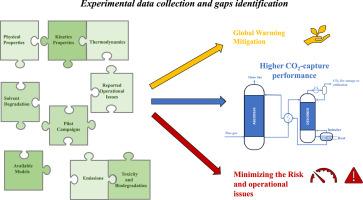Available data and knowledge gaps of the CESAR1 solvent system
引用次数: 0
Abstract
Amine-based chemical absorption stands out as the leading technology for post-combustion CO2-capture. A blend of 3 M 2-amino-2-methyl-1-propanol (AMP) and 1.5 M piperazine (PZ), also known as CESAR1, has proven to outperform the current benchmark ethanolamine (MEA), exhibiting better energy performance and lower degradation rates. This review aims to gather all the experimental laboratory and pilot available data for CESAR1 and its constituent components. Experimental gaps to develop reliable process models are detected and future experiments are proposed. An overview of the knowledge related to amine and degradation compound emissions and environmental impacts of CESAR1, together with hands-on experience in operating the solvent, is presented in this review.
The main findings of the review are that sufficient physical properties, N2O-solubility, and speciation data for the CESAR1 solvent are not available in the open literature, even though necessary for the development of reliable process models. A review of the degradation compounds for AMP, PZ and AMP/PZ blends outlines that the nitrogen balance for AMP and PZ is not closed, meaning that there still are compounds that need identification and quantification in the degraded solvent. Given the higher volatility of AMP compared to MEA, a better understanding of the formation and behaviour of aerosol and gas phase emissions is required. A review of pilot plant campaigns for AMP/PZ blends shows that CESAR1 performs better in terms of energy compared to MEA and degrades less. There is, however, the need for high-quality pilot campaigns where all data needed for process model validation is provided for the scientific community. Finally, amine emission mitigation strategies and data on the environmental impact and toxicity of AMP and PZ are presented and discussed.

CESAR1 溶剂系统的现有数据和知识差距
胺类化学吸收技术是燃烧后捕集二氧化碳的领先技术。事实证明,3 M 2-氨基-2-甲基-1-丙醇(AMP)和 1.5 M 哌嗪(PZ)的混合物(也称为 CESAR1)优于目前的基准乙醇胺(MEA),表现出更好的能量性能和更低的降解率。本综述旨在收集有关 CESAR1 及其组成成分的所有实验室和试验数据。发现了在开发可靠工艺模型方面存在的实验差距,并提出了未来的实验建议。本综述概述了与胺和降解化合物排放以及 CESAR1 对环境的影响有关的知识,并介绍了操作该溶剂的实践经验。综述的主要发现是,尽管对于开发可靠的工艺模型十分必要,但公开文献中并没有关于 CESAR1 溶剂的充分的物理性质、N2O 溶解性和规格数据。对 AMP、PZ 和 AMP/PZ 混合物的降解化合物进行审查后发现,AMP 和 PZ 的氮平衡尚未结束,这意味着降解溶剂中仍有一些化合物需要识别和定量。鉴于 AMP 与 MEA 相比具有更高的挥发性,因此需要更好地了解气溶胶和气相排放物的形成和行为。对 AMP/PZ 混合物试点工厂活动的审查表明,与 MEA 相比,CESAR1 的能量表现更好,降解也更少。不过,需要开展高质量的试验活动,为科学界提供工艺模型验证所需的所有数据。最后,介绍并讨论了胺排放缓解策略以及 AMP 和 PZ 对环境的影响和毒性数据。
本文章由计算机程序翻译,如有差异,请以英文原文为准。
求助全文
约1分钟内获得全文
求助全文

 求助内容:
求助内容: 应助结果提醒方式:
应助结果提醒方式:


